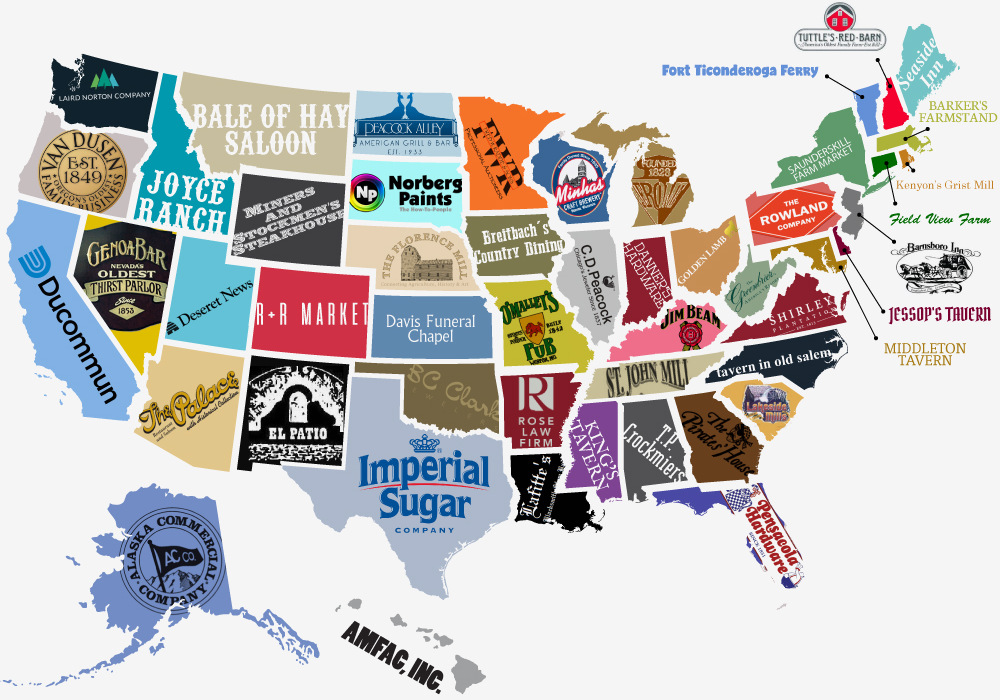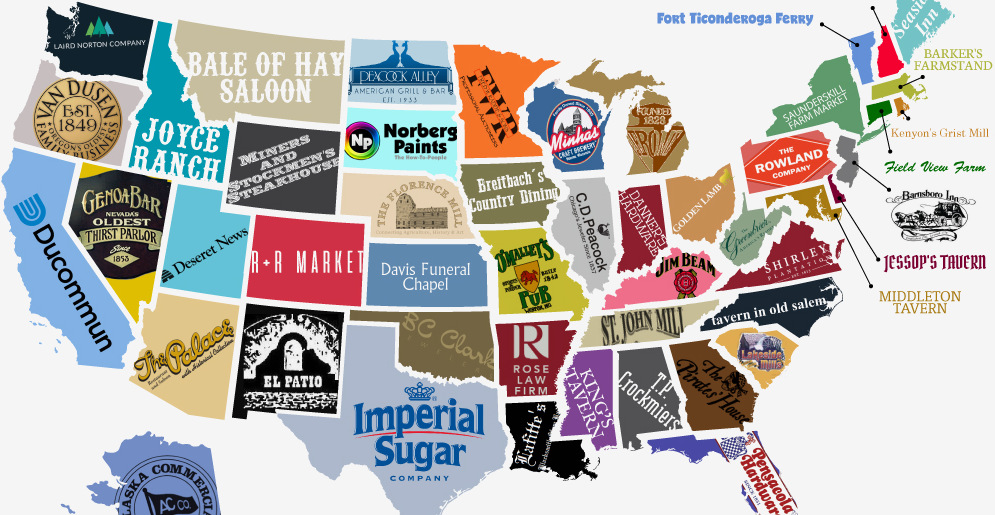Misc
The Oldest Business in Each State

Oldest Business in Each State
Is the oldest business in your state a mom-and-pop shop, or a famous megabrand?
Today’s infographic from Busy Beaver Button Co. maps the diverse range of companies that claim to be the oldest in their respective states. While many of them exist today as modest family-owned businesses such as pizzerias or taverns, some have also grown into respected brands known around the country, like Jim Beam or Imperial Sugar.
The Most Interesting Standouts
Here are the standouts from the list, including a pirate-themed restaurant and a global aerospace company.
Georgia: The Pirates’ House (est. 1753)
Located in downtown Savannah, The Pirates’ House is thought to be the oldest standing building in the state of Georgia. It was once an inn and tavern for seaman visiting from abroad, developing quite a negative reputation among the locals for scoundrelry and drunkenness. Today, the restaurant is obviously more family-friendly – and it is one of Savannah’s most-popular tourist attractions.
California: Ducommun (est. 1849)
Ducommun is an aerospace and defense manufacturer based founded in Carson, California with a current $320 million market capitalization on the NYSE. The company manufactures structural and electronic components for commercial, military, and space aircraft, including the Boeing 737 NG and 777 airliners.
Kentucky: Jim Beam (est. 1795)
Amazingly, seven generations of the Beam family have been involved in whiskey production for the company since it was founded in 1795. After Prohibition impacted the business, the company was rebuilt by James B. Beam, and the whiskey still bears his name today.
Texas: Imperial Sugar (est. 1843)
Located in the aptly-named Sugar Land, Texas, this company is a sugar behemoth with revenues of nearly $1 billion per year. Imperial Sugar focuses on producing sugar products and sweeteners that are made from non-GMO cane sugar.
Vermont: Fort Ticonderoga Ferry (est. 1799)
The oldest business in Vermont is not a multi-national brand – but instead, a quaint seven-minute ferry ride that provides scenic daytime crossings on Lake Champlain between Ticonderoga, New York and Shoreham, Vermont.
VC+
VC+: Get Our Key Takeaways From the IMF’s World Economic Outlook
A sneak preview of the exclusive VC+ Special Dispatch—your shortcut to understanding IMF’s World Economic Outlook report.

Have you read IMF’s latest World Economic Outlook yet? At a daunting 202 pages, we don’t blame you if it’s still on your to-do list.
But don’t worry, you don’t need to read the whole April release, because we’ve already done the hard work for you.
To save you time and effort, the Visual Capitalist team has compiled a visual analysis of everything you need to know from the report—and our VC+ Special Dispatch is available exclusively to VC+ members. All you need to do is log into the VC+ Archive.
If you’re not already subscribed to VC+, make sure you sign up now to access the full analysis of the IMF report, and more (we release similar deep dives every week).
For now, here’s what VC+ members get to see.
Your Shortcut to Understanding IMF’s World Economic Outlook
With long and short-term growth prospects declining for many countries around the world, this Special Dispatch offers a visual analysis of the key figures and takeaways from the IMF’s report including:
- The global decline in economic growth forecasts
- Real GDP growth and inflation forecasts for major nations in 2024
- When interest rate cuts will happen and interest rate forecasts
- How debt-to-GDP ratios have changed since 2000
- And much more!
Get the Full Breakdown in the Next VC+ Special Dispatch
VC+ members can access the full Special Dispatch by logging into the VC+ Archive, where you can also check out previous releases.
Make sure you join VC+ now to see exclusive charts and the full analysis of key takeaways from IMF’s World Economic Outlook.
Don’t miss out. Become a VC+ member today.
What You Get When You Become a VC+ Member
VC+ is Visual Capitalist’s premium subscription. As a member, you’ll get the following:
- Special Dispatches: Deep dive visual briefings on crucial reports and global trends
- Markets This Month: A snappy summary of the state of the markets and what to look out for
- The Trendline: Weekly curation of the best visualizations from across the globe
- Global Forecast Series: Our flagship annual report that covers everything you need to know related to the economy, markets, geopolitics, and the latest tech trends
- VC+ Archive: Hundreds of previously released VC+ briefings and reports that you’ve been missing out on, all in one dedicated hub
You can get all of the above, and more, by joining VC+ today.
-

 Energy1 week ago
Energy1 week agoThe World’s Biggest Nuclear Energy Producers
-

 Money2 weeks ago
Money2 weeks agoWhich States Have the Highest Minimum Wage in America?
-

 Technology2 weeks ago
Technology2 weeks agoRanked: Semiconductor Companies by Industry Revenue Share
-

 Markets2 weeks ago
Markets2 weeks agoRanked: The World’s Top Flight Routes, by Revenue
-

 Demographics2 weeks ago
Demographics2 weeks agoPopulation Projections: The World’s 6 Largest Countries in 2075
-

 Markets2 weeks ago
Markets2 weeks agoThe Top 10 States by Real GDP Growth in 2023
-

 Demographics2 weeks ago
Demographics2 weeks agoThe Smallest Gender Wage Gaps in OECD Countries
-

 Economy2 weeks ago
Economy2 weeks agoWhere U.S. Inflation Hit the Hardest in March 2024












